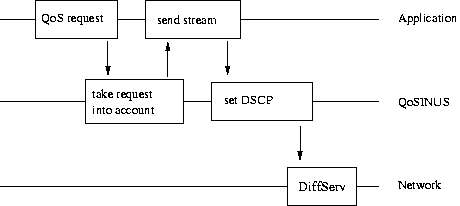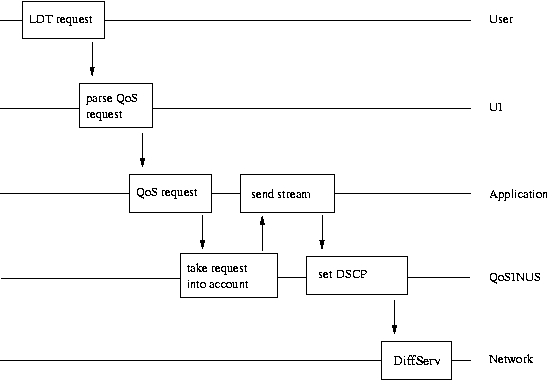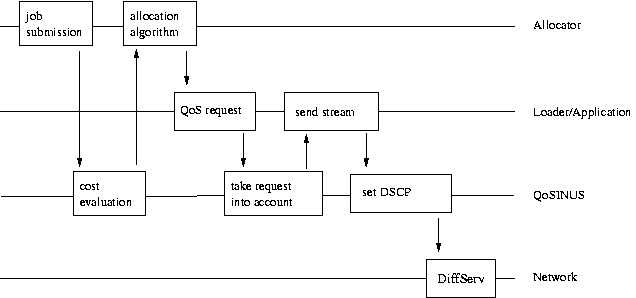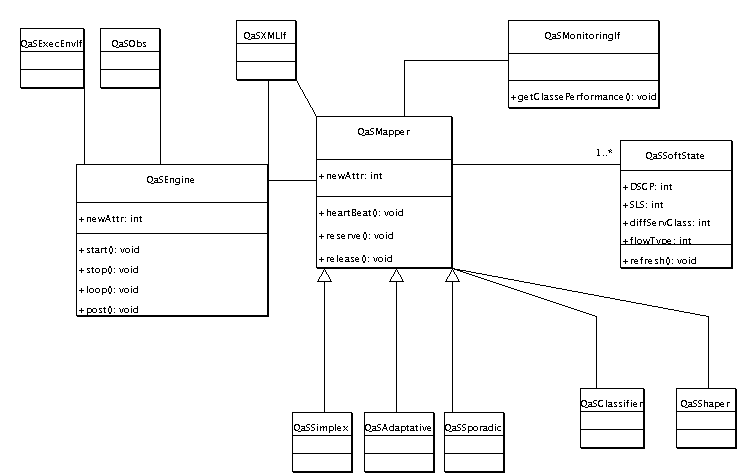QoSINUS
QoS INvocation and Usage System
[
Introduction |
Use case example |
Current implementation |
Future works |
Download |
Documents |
Contacts
]
Introduction
Nowadays, many routers used in high-performance core networks
implement QoS fonctionalities. This is true, for example, in VTHD,
which is the core network the e-Toile grid is build on. The routers of
this high-performance network provide differentiated classes services
(DiffServ) for that network's traffic. Four classes are available,
respectively called EF, AF/TCP, AF/UDP, BE. The data packets are
marked in one of those classes, and receive the forwarding treatment
associated to that class at the routers.
Applications need that a certain level of QoS is ensured to the
transmission of their data. But it might not be straightforward for
them to translate their need into a DiffServ class. It would be nice
instead, if they could specify such a level of QoS in a more abstract
manner. For example, they could be given the option to specify a
minimum bandwidth, a maximum loss and/or a maximum delay for their
data streams. They might even be interested in defining their request
using not only quantitative values but also qualitative values, like
"high", "medium" or "low". Say, for example, that an application needs
to transmit an audio stream. This kind of application is not that much
concerned about loss of packets, requires a medium bandwidth, but has
a strong need of low delay of transmission. It could then express it's
QoS need as follow: "delay=low, rate=medium".
The programmable QoS system that we propose for is the glue between
such an application high level QoS request and the backbone routers
DiffServ forwarding treatment. The aim of the architecture is to map a
high level QoS request into a DiffServ class, using monitoring
informations. To provide that functionality, an active service is
running on the router located at ingress of the DiffServ enabled
backbone. It is responsible for monitoring the behavior of each
DiffServ class in the core network, in terms of delay, loss and
rate. Upon reception of a high level QoS request, it uses those
monitoring pieces of information to determine the DiffServ class that
matches the request the best. When the client's data stream is
emitted, it's also up to this active service to mark the data packet
in the chosen class, so that the corresponding DiffServ forwarding
treatment is applied in the core network, and the requested QoS
ensured.
The system described so far provides a mean to request a certain level
of QoS and to actually provide that QoS to a transmission. On top of
that mechanism, a policy has to be enforced, that defines how the QoS
is negociated. The goal here is to control what QoS level might be
granted to which stream. The e-Toile middleware includes a component,
called the allocator, that takes care of job allocation on the
Grid. That component is responsible for chosing the computing elements
on which a job is going to be executed. As such, it is the piece of
software that decides what is the destination of the grid's data
streams. This allocator seems like a good candidate to enforce the QoS
policy (ensure the network ressource allocation), just the same way he
ensures the computing power allocation.
Use case examples in a Grid context
To help understand how the system works and might be used, here are
four uses cases of QoSINUS showing how it could be integrated in a
Grid environment.
-
Use case 0
In this first straighforward case, an application wants to control the
DSCP that is used in its streams packets. QoSINUS includes a override
mechanism that allows bypassing it completly to deal with that case.
-
Use case 1
Here, the sender of the data streams is responsible for specifying the
QoS level for its streams to QoSINUS. That's the case of an
application that sends data independly from the Grid
middleware. That's also the case of Grid middleware specific data
streams, like for example, the streams that flow when the Grid user
interface requests the display of the Grid's useage statistics.
The figure below shows this kind of use case.

-
Use case 2
The QoS might also be specified directly by the Grid's user. He might
want, for example, to define the thruput to be assured to the transfer
of the result data of his/her job. In this case, the QoS request is
part of the job submission parameters (expressed in LDT, "langage
d'expression des travaux"). The Grid's UI component is responsible for
extracting this request, as shown below.

-
Use case 3
Finally, it might be up to the grid middleware itself to define the
QoS to assure to the data streams circulating in the grid's network.
Here the Grid's allocator, that is responsible for deciding where a
job is going to be executed, sees the network as a ressource just like
computing or storage elements. It takes its allocation decission
taking into account a network transfer cost evaluation. Once the job
is allocated, the Grid's middleware specify the QoS for the streams
generated by the job's loading procedures, as shown below.

Current implementation
Architecture
QoSINUS is an active service that runs in the TAMANOIR active networking execution environment.
It consists in two part: a client API that is used by applications to
request QoS to be ensured to their data stream, and an active service
that runs on TAMANOIR active routers, deployed at the edge of the
DiffServ domains.
Client API
The following functions are available for the client applications to use:
-
QoS_Set:
This function lets an application specify its QoS needs in terms of
delay, rate and loss. The QoS requirements are qualitatives or
quantitatives (high, medium, low) values.
-
QoS_Invoke:
This function is called by the client application to let QoSINUS know
that it is going to start to send its data stream for which QoS was
requested.
-
QoS_Release:
Once it's done sending its data, the application call this function to
let QoSINUS know that it can release the QoS ressource allocated for
its stream.
-
QoS_Request:
This function let the client application specify its QoS needs in a
more detailed way than QoS_Set. The QoS request is expressed in an Xml
format that may include the following pieces of information:
-
the stream ID identifying the stream by mean of its source, its
destination, its protocol or a DSCP.
-
the conformance, describing the rate that the application will not
exceed.
-
the excess treatment describing how to handle (i.e. drop/shape/remark) packets that are not
conform.
-
the guarantees requested, in terms of delay, rate and loss rate.
-
the schedule specifying when and for how long the stream will be sent.
Active service
The QoSINUS active service might be broken into several components, as
shown in the class diagram below. This service is running on the
TAMANOIR active routers located at the DiffServ domain edges.

-
QaSEngine is the heart of the system. It's an in infinite loop handling three kinds of events:
- new QoS request reception
- QoS ressources release command
- and timer pulses used to detect "dead" streams and automatically
release their ressources after a certain time of inactivity (soft
state system allowing for a robustness in the case where the client
stops before releasing its ressources).
-
QaSExecEnvIf is the interface with the TAMANOIR environment with
packets are received and sent.
-
QaSMapper is the algorithm that maps a QoS request to a DiffServ class
to be used in the DiffServ domain. QaSStaticMapper,
QaSAdaptativeMapper and QaSSporadicMapper are different
implementations of that algorithm.
-
QaSStreamStatus is the list of streams that the system handles. For
each stream, it's identifier, the SLS corresponding to the QoS
request, the DiffServ class used, and an activity flag are saved.
-
QaSClassStatus includes pieces of information about the DiffServ
classes to be found in the DiffServ domain. For each class, the total
allocated bandwidth and the available bandwidth are kept up to date.
-
QaSKernelIf intefaces QoSINUS with the Linux kernel's netfilter and tc
modules. Those modules are used to set the DSCP of the packets and
limit the bandwidth used by a stream according to QaSMapper
decissions.
-
QaSMonitoringIf provides QaSMapper with monitoring information for
each DiffServ class in the DiffServ domain.
-
QaSPolicy is a hook allowing a policy management system, that could be
the grid's allocator, to accept or deny a QoS request.
-
QaSXMLIf is used to parse the QoS request expressed as an XML SLS
document.
-
QaSObsIf make it possible to publish status information of the
service. This status can be viewed using a tool like MapCenter for
example.
Mapping algorithm
Two mapping strategies have been implemented so far.
-
Static mapping is a first straigh forward implementation. Here the
bandwidth available at the DiffServ domain ingress point is statically
shared among the DiffServ classes. The mapping between a QoS request
and a DiffServ class is defined by simple static rules, like "short
delay implies Premium DiffServ class".
Upon reception of a QoS request, a DiffServ class is thus
chosen. If enough bandwidth is still available for that class, the QoS
request is accepted, and the chosen class's available bandwidth
is updated. Otherwise the Qos request is rejected.
-
The dynamic mapping adopts another approach. Here, the DiffServ
classes performance (in terms of round trip time, loss rate, and
possibly available bandwidth) are measured dynamically. Based on that
information the system periodically chooses the best DiffServ class to
use for each stream and can thus adapt to performance variations of
the DiffServ classes in the core network.
Download
Contacts



